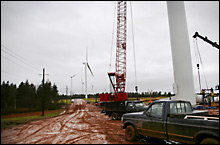 Prince Edward Island has a problem. They are rural, far away from any fossil fuel sources, and have to ship all their energy needs in from off island (at high cost). So what is a tiny province in Canada’s windy north east supposed to do? Simple bust out some renewable energy technology and launch themselves into the forefront of renewable energy production.
Prince Edward Island has a problem. They are rural, far away from any fossil fuel sources, and have to ship all their energy needs in from off island (at high cost). So what is a tiny province in Canada’s windy north east supposed to do? Simple bust out some renewable energy technology and launch themselves into the forefront of renewable energy production.
from here
Prince Edward Island aims to generate 30 percent of its energy needs from its own renewable resources by 2016.
If you want a glimpse of this province’s energy future, drive the winding country roads to its eastern tip, take a left at the sign for the village of Elmira, and follow the red dirt track to the right.
You can’t miss it. Ten wind turbines stand along the trail, each 26 stories tall, with blades as long as 125 feet. When workers finish the last one this month, the new Eastern Kings Wind Farm will generate 30 megawatts of electricity – 7.5 percent of the province’s power – by harnessing the strong winds that buffet the island’s northern shore.
But more than an isolated project, the wind farm is part of an ambitious plan to enable Prince Edward Island (PEI) – which has no significant coal, petroleum, natural gas, or hydro resources – to meet most of its electricity and 30 percent of its total energy needs from its own renewable resources by 2016. If successful, government officials say, this remote rural province will find itself at the cutting edge of the world’s fastest growing energy sector.
“Right now we have to bring almost all of our energy in from off-island at great expense” – $440 million a year (US$384 million and 11 percent of GDP), says Jamie Ballem, minister of environment and energy. “If we can produce a third of that right here from renewable sources that’s going to help the local economy and the environment.”
In addition to the Eastern Kings project, PEI’s government is backing the creation of a hydrogen-powered village as well as expansions to existing wind farms on the northwestern tip of the island. Private companies, meanwhile, are building plants to produce ethanol from locally grown sugar beets and residential heat from forestry and farming waste. Hydrogen-powered buses and boats may follow, whisking passengers around the island with fuel cells charged by wind-power.
…
The electricity-generating potential of the island’s greatest energy resource – the wind – was recognized decades ago, and in 1980 Canada built its national wind test center on the island’s northwestern tip. When the provincial government adopted its renewable energy strategy in 2004, expanding wind power was the first priority.
Two years later, three new wind farms are nearing completion – two built by a private firm, the other by the public utility, PEI Energy Corp. When completed in the coming months, wind will provide 15 percent of PEI’s electricity, reducing the province’s carbon dioxide emissions by 90,000 tons each year. The island’s overall wind potential is about five times that, according to the government.
What is so interesting about this is that PEI could be any small community in America. If the national government wont develop a comprehensive renewable energy strategy, do it yourself. Communities like Hull Massachussetts are already doing just that.